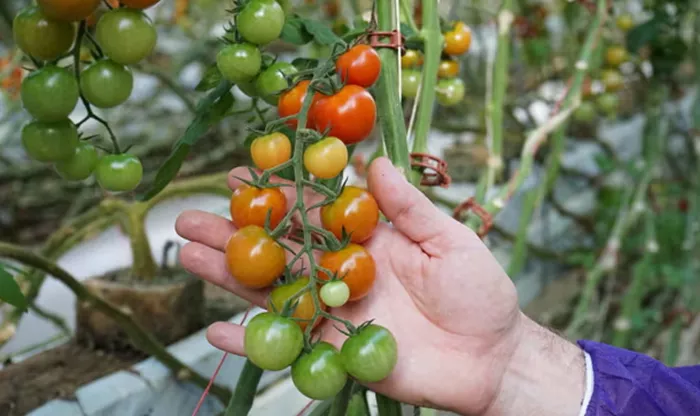The Australian tomato industry is grappling with its most significant biosecurity challenge to date, two months after an exotic disease led to the indefinite quarantine of three South Australian businesses. This situation has resulted in over $20 million in losses and has disrupted some interstate and international trade.
The tomato brown rugose fruit virus likely entered Australia through seeds imported from Europe in May. It was detected in August when staff at Perfection Fresh’s glasshouse in Two Wells, north of Adelaide, noticed infected plants.
Extensive testing of more than 3,700 samples confirmed that the virus was limited to the Two Wells glasshouse, one of Australia’s largest, and two nearby farms: Gawler River Tomatoes and the SA Tomato Nursery. Consequently, all three locations were placed under quarantine. Hundreds of workers were stood down, and over one million plants are being destroyed.
Initially, authorities expected the quarantine to last a few weeks. However, Nick Secomb, the director of plant and invasive species biosecurity at the Department of Primary Industries and Regions (PIRSA), now estimates it could extend for several more months.
Key decisions still need to be made regarding the duration of the quarantine, decontamination processes, potential compensation, and how producers can prove that their plants and fruits are free from the contagious virus, which can also harm capsicums and chillies.
Secomb explained that without proper treatment, the virus can survive for up to four months on inert surfaces. He cited European studies indicating that the virus could remain present for several months if not treated.
The virus was first identified in Israel in 2014 and has since spread to the UK, Europe, the US, Mexico, and China. To strengthen biosecurity, Australia tightened its testing regime for importing tomato and capsicum seeds in 2019.
Secomb noted that while they have previously eradicated similar viruses, they faced delays because only two interstate laboratories were accredited to handle this virus. Recently, an Adelaide lab received approval to test for the virus, which will expedite the testing process for growers needing certification.
Due to the outbreak, New Zealand and New Caledonia have suspended imports of all Australian tomatoes. Additionally, Queensland and Western Australia have banned all host fruits—tomatoes, chillies, and capsicums—from South Australia. New South Wales and Tasmania have also tightened regulations for interstate trade.
While infected tomatoes pose no threat to human health, consumers and home gardeners are urged to report any unusual symptoms, such as deformities, yellow spots, or wrinkled patches.
Jordan Brooke-Barnett, CEO of AUSVEG SA, noted that the sector and consumers have largely avoided severe consequences, with no significant supply shortages or price increases reported in Australia. There is hope for Western Australia to reopen its borders to South Australian fruit.
However, the impact on the three quarantined businesses has been severe, with losses exceeding $20 million and continuing to rise. Michael Simonetta, CEO of Perfection Fresh, criticized the government’s response as excessive.
“This virus is being managed everywhere else in the world,” he said. “Growers deal with viruses every day. It blows my mind. We were managing the virus before the shutdown; it wasn’t affecting our fruit quality or yields.”
Despite having the capacity to isolate the 43-hectare glasshouse into 27 zones, Simonetta claims authorities are treating the entire site as one, leading to the destruction of all 1.3 million plants.
Almost 300 Perfection Fresh workers have been laid off, with another 150 expected to be let go once the plants are removed. A support hub established in the nearby town of Virginia is helping affected workers access government assistance and find jobs in other farms and meat processors.
Simonetta stated that Perfection Fresh’s losses are already in the “tens of millions of dollars,” increasing by hundreds of thousands of dollars each week. There is also nearly $1 million worth of seedlings on order that were scheduled to be planted this week.
“If they say we can start today, we’re still four to six months away from any production,” he warned. “But to return to full production, we’re looking at 12 to 18 months.”
Brooke-Barnett described the virus as the biggest threat to the Australian tomato industry, acknowledging that an outbreak was inevitable. Nonetheless, Professor Geoff Gurr, an applied ecology expert at Charles Sturt University, emphasized the importance of preventing the virus from becoming established, which would help Australian growers maintain their competitive edge in global markets.
A 2020 analysis from the University of Melbourne valued Australia’s biosecurity system at $314 billion over 50 years, yielding a net return on investment of 30:1. Gurr remarked, “The benefits of keeping harmful pests and diseases out of Australia are immense. The investment we make in biosecurity is minimal compared to the potential returns.”
South Australia is the largest producer of glasshouse tomatoes in Australia, with 94 hectares yielding nearly 45,000 tonnes valued at $148 million in 2022-23, according to the Australian Horticulture Statistics handbook. Overall, Australian tomato growers produced more than 320,000 tonnes valued at $570 million.
Related topics:
- Friends of Himmel Park Blossom: Seven New Trees Take Root
- Dry Spell Hits Flower Farmers Hard at Rehoboth Beach Farmers Market
- Farmers Gather Vibrant Marigold Blooms in Ichangu Narayan


